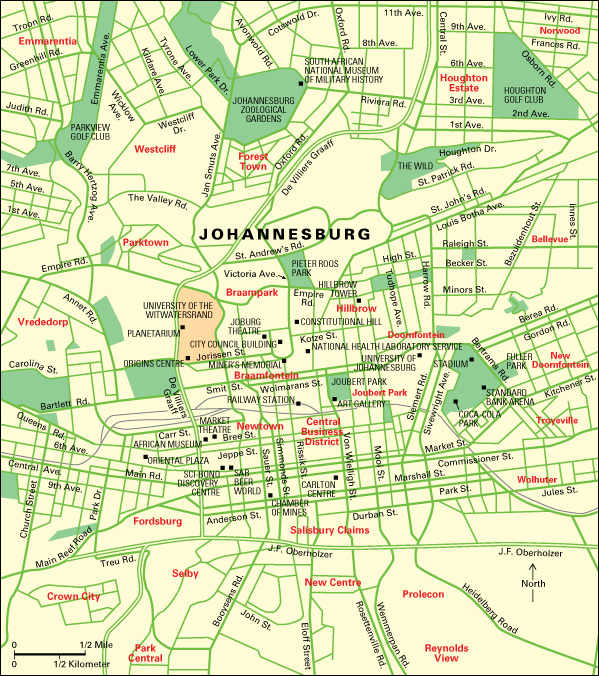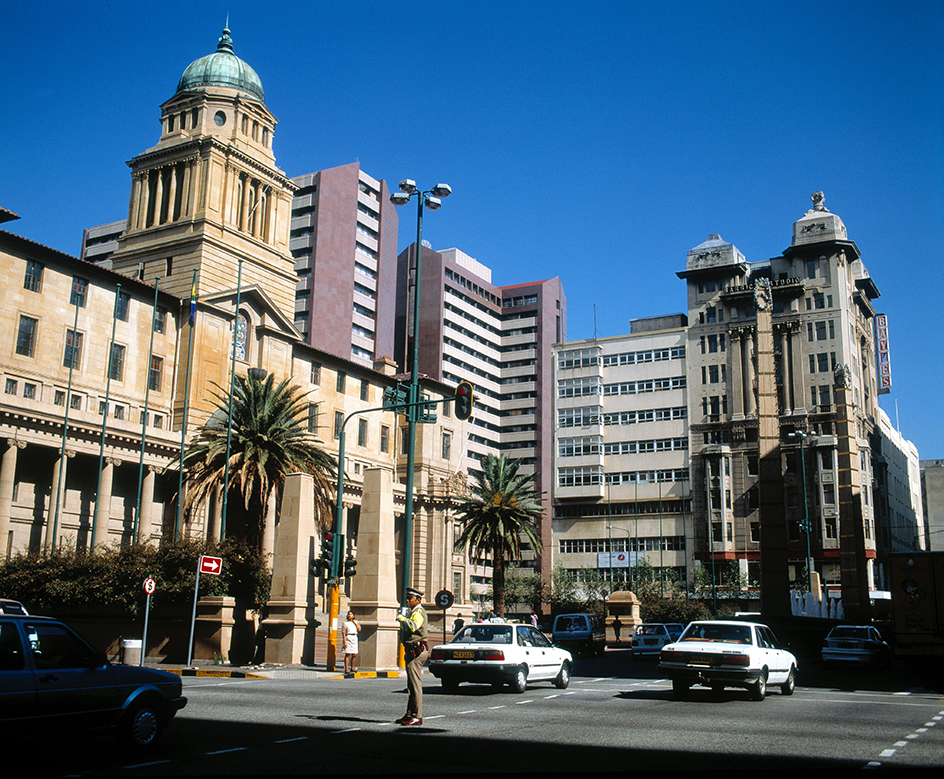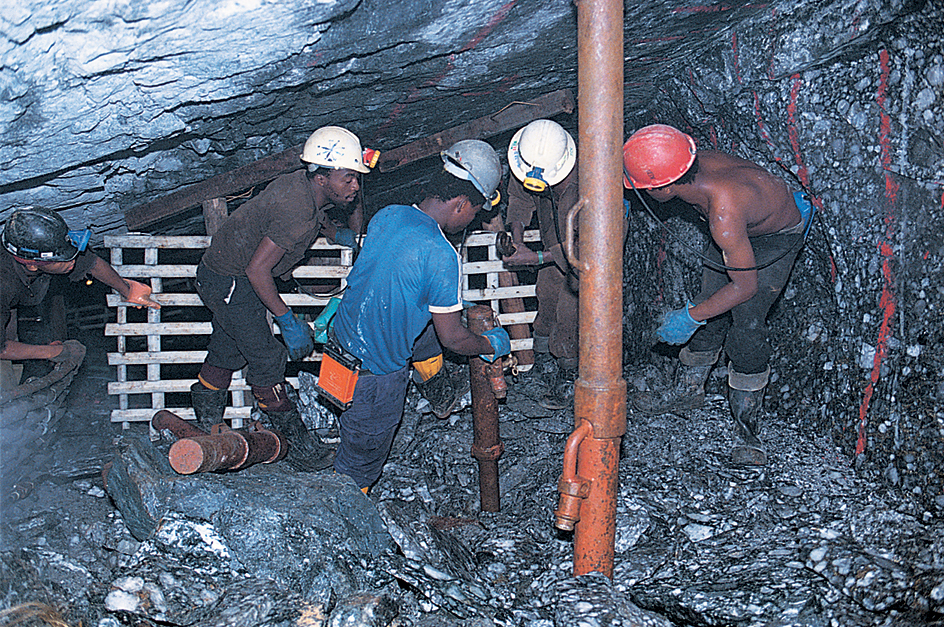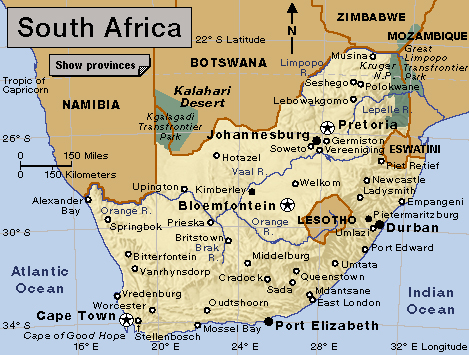Johannesburg << joh HAN ihs `burg` >> (pop. 4,803,262) is the largest city in South Africa. It is also the most important industrial, financial, and commercial center in Africa south of the Sahara. Johannesburg is the capital of the province of Gauteng in the northeastern part of South Africa.

Johannesburg lies in the heart of the Witwatersrand, historically the richest gold field in the world. The name Witwatersrand means ridge of white waters in the Afrikaans language. The Witwatersrand serves as a watershed—that is, a ridge between two river systems. Several streams run off the watershed. Rain falling north of the ridge eventually runs into the Indian Ocean, and south of the ridge it runs into the Atlantic Ocean.
Johannesburg was founded in 1886. Gold mining drew laborers and fortune seekers to the area, and Johannesburg rapidly became southern Africa’s largest city. Today, Johannesburg is one of the most modern and prosperous cities in Africa. It is the hub of South Africa’s commercial, financial, industrial, and mining activities. Many people refer to the city as Jo’burg. It is also often called iGoli, a Zulu name meaning “City of Gold.”
Since 1995, the city of Johannesburg has included the formerly separate Black African township of Soweto. About 1,700,000 people live in the Soweto area, which is southwest of the city center. During the 1900’s, many Black Africans were forcibly relocated to the Soweto area as part of efforts to impose racial segregation. From the late 1940’s to the early 1990’s, these segregation efforts were part of an official South African policy known as apartheid. The name Soweto comes from the first two letters of each of the words South Western Townships. See Apartheid; Soweto.

The city
Johannesburg is one of the world’s highest cities. Its highest point lies about 6,000 feet (1,800 meters) above sea level on the Highveld, which is part of South Africa’s interior plateau. The city covers a total area of 635 square miles (1,644 square kilometers). The Central Business District (CBD) covers about 1 square mile (2.5 square kilometers) in the city center. It consists of closely packed, multistory buildings, including the 732-foot (223-meter) Carlton Centre, a former office building that is now a residential structure. The CBD features a variety of shops and restaurants. Tens of thousands of shoppers from the region visit the CBD each month.
Dumps left behind by early gold miners are a feature of Johannesburg’s cityscape. Some of these areas have been improved by planting and landscaping. Others are being reworked to extract any gold that may be still there. The city also has many parks, reserves, and walking trails.
The city of Johannesburg incorporates several communities that were once separate towns or townships. These communities include Alexandra, Ennerdale, Lenasia, Midrand, Randburg, Roodepoort, Sandton, and Soweto. They were merged with Johannesburg starting in 1995, after South Africa repealed the last of its apartheid laws. Alexandra and Soweto had been separate apartheid townships for Black Africans. Ennerdale had been a separate township for Coloured (mixed-race) people, and Lenasia had been a separate township for people of South Asian descent.
Johannesburg is a modern and exciting city. Many of the city’s older buildings have been pulled down, and modern structures have been built in their place. North of the CBD is Hillbrow, the most densely populated residential area in southern Africa. Thousands of people live in its towering apartment buildings. The 883-foot (269-meter) Hillbrow Tower and the 748-foot (228-meter) Leonardo skyscraper are two of the tallest structures in Africa. Northwest of the CBD is Braamfontein, another area of offices and businesses. Since the 1980’s, many of Johannesburg’s offices and commercial activities have relocated north to suburban areas such as Parktown and Rosebank, and to neighboring towns such as Midrand, Randburg, and Sandton. The Oriental Plaza, an Indian shopping complex west of the CBD, attracts many people.
Johannesburg’s residential areas range from luxurious, wooded suburbs, to former townships with two- and four-room “matchbox” houses, to shantytowns and squatter settlements. Since the 1980’s, large numbers of people have moved to Johannesburg in search of work. A lack of housing in the city has forced many to set up squatter settlements. Most of these communities lack electric power and running water, and residents generally live in makeshift shacks built from scrap metal, boards, and other discarded materials. In some of these settlements, town planners have begun to lay down streets and provide residents with basic services. High-density and high-rise buildings in Hillbrow and the CBD also house lower-income people.
People
Ancestry.
The people of Johannesburg represent a variety of cultures and come from many parts of the world. Early occupants of the Johannesburg area were Sotho- or Tswana-speaking Africans. The first gold rush, which began in 1886, attracted prospectors from many countries. By 1900, about 10,000 migrant workers from India had made their homes in Johannesburg.
Today, people of African ancestry outnumber all others in the city. Many of them are Zulu (isiZulu) speakers. Others speak Sesotho, Tswana (Setswana), or Afrikaans. Many of them are second- or third-generation citizens of the city and no longer have strong links with their rural origins. People of European, Asian, and mixed ancestry and immigrants from other African countries make up a minority of Johannesburg’s population.
Education and culture.
Johannesburg has two universities. The University of the Witwatersrand, established as a university in 1922, grew out of the South African School of Mines. The University of Johannesburg was established in 2005 when two former institutions, Rand Afrikaans University and Technikon Witwatersrand, merged. South Africa’s largest disease research institution, the National Health Laboratory Service, has its headquarters in Johannesburg.
Johannesburg has a number of libraries, galleries, and museums. Specialized museums cover such subjects as Africana, anthropology, costume, geology, medicine, military history, photography, and transportation. Gold Reef City, a living museum, includes a restored mine that was part of the Crown Mines complex. Visitors can descend about 11,480 feet (3,500 meters) to see where gold was once mined. In November 2001, the Apartheid Museum opened. It provides a multimedia walk through the history of apartheid in South Africa.
The Market Theatre stages plays, comedy shows, and musical performances. The Civic Theatre complex features plays and dance performances. Concerts are held in the City Hall. Ellis Park is a venue for international sporting events.

Economy
Johannesburg is the commercial, financial, and industrial center of sub-Saharan Africa. About two-thirds of the working population is employed in service industries, commerce, and manufacturing. Other residents of the city work in construction, mining, transportation, and utilities. The city’s economy was originally based on gold, and some of the city’s service and manufacturing industries continue to depend on gold mining. But over the years, the economy has developed and become diverse. Most industrial and manufacturing areas are in the southern part of the city and south of the city limits, and most service and commercial areas are in the north.
A number of Johannesburg’s service industries are in some way associated with gold mining, including banks, the Chamber of Mines, mining houses, and the stock exchange. The stock exchange, known as the JSE Securities Exchange, is the largest stock exchange in Africa. It was originally housed in the CBD in a multifaceted glass building resembling a cut diamond, but it moved its headquarters to Sandton in 2000.

The most common forms of transport for Johannesburg residents are buses and minibus taxis. A commuter rail system serves Johannesburg and the surrounding area. OR Tambo International Airport (formerly Johannesburg International Airport) handles both domestic and international flights. A high-speed rail network connects the airport, central Johannesburg, and the nearby city of Pretoria. The city is also a road and rail center for southern Africa.
Government
Johannesburg is one of South Africa’s six metropolitan municipalities. The others are Cape Town; eThekwini, which includes the city of Durban; Ekurhuleni, also known as the East Rand; Tshwane, which includes the city of Pretoria; and Nelson Mandela Bay, which includes the city of Port Elizabeth. An executive mayor and a 217-member municipal council oversee the Johannesburg municipality. The municipality is divided into 11 administrative regions.

History
Archaeologists in the Johannesburg area have discovered the remains of a complex of Iron Age villages, dating from about 1100 B.C. A wave of new settlers who were skilled in metalworking arrived in the A.D. 500’s or earlier and built permanent cities. These early settlers were Sotho-Tswana. The first settlers of European ancestry moved into the Highveld in the 1830’s. The first traces of gold were discovered in the 1850’s.
In 1886, an Australian prospector named George Harrison discovered gold in the region, sparking a major gold rush. Public gold diggings were declared, and fortune seekers flocked to the region, rapidly building a tent and hut community on the site. On Oct. 4, 1886, a town was proclaimed and laid out. Eleven years later, Johannesburg was declared a municipality, with its own council and mayor. In 1928, it was chartered as a city.
In 1994, the South African province of PWV (Pretoria-Witwatersrand-Vereeniging) was created, and Johannesburg was named the province’s capital. In 1995, PMV was renamed Gauteng, and the Greater Johannesburg metropolitan area was restructured. The administration of the region was divided between an elected council for the entire metropolitan area and local elected councils for four metropolitan “substructures.” In 2000, the government of Johannesburg was changed again to create a metropolitan municipality, or “unicity,” governed by a single elected council.
See also Witwatersrand; Witwatersrand, University of the.
